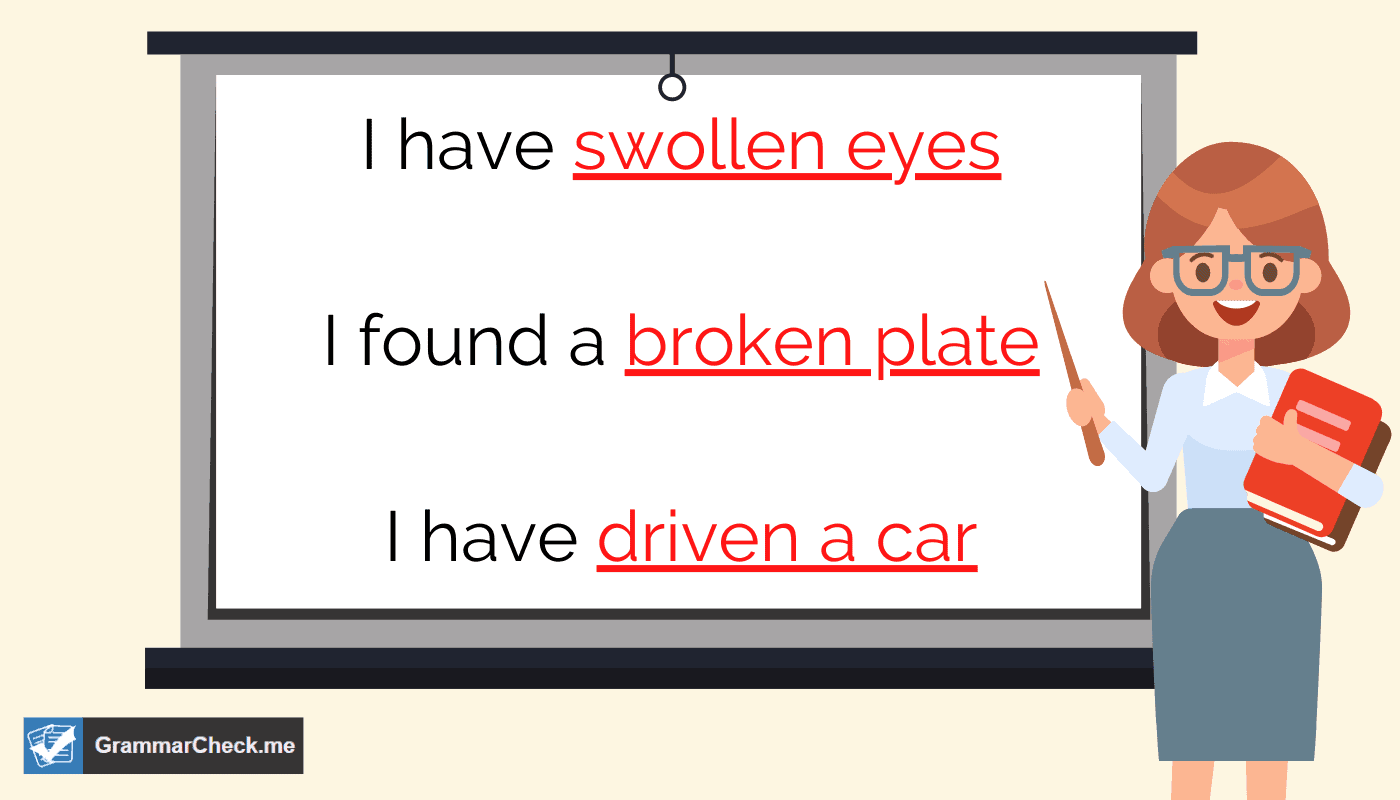The past tense of a verb indicates an action that happened in the past, for example, “walked” or “ate.” The past participle is a verb form used mainly in perfect tenses and passive voice, like “walked” (which can be the same as past tense), “eaten,” or “written.” Past participles typically end in -ed, -d, -t, -en, or -n.
The English language has a variety of ways of describing the past, present, and future, many of which confuse even native English speakers. However, using the proper verb tenses in your writing is crucial to ensure that your reader clearly understands your message.
Past tense and past participle are two tenses that may seem the same but serve different purposes. In this article, we explore the differences between past tense vs past participle, when to use each tense, and examples of each in a sentence.
| Aspect | Definition | Examples | Usage |
|---|---|---|---|
| Past Tense | Denotes an action that occurred in the past. | ‘Walked’, ‘Ate’, ‘Finished’ | Indicates completed actions or states in the past. |
| Past Participle | Used in perfect tenses and passive voice, usually ending in -ed, -d, -t, -en, or -n. | ‘Walked’ (same as past tense), ‘Eaten’, ‘Written’ | Forms perfect tenses (like present perfect) and passive voice constructions. |
What Is Past Tense?

Past tense is one of the three major English verb tenses, which are:
- Past
- Present
- Future
Past tense describes an action or state that took place in the past. This is perfectly illustrated by looking at the difference between he has risen vs he is risen. Past tense is an umbrella term as there are several sub-categories under past tense, including:
- Simple past tense
- Past continuous tense
- Past perfect tense
- Past perfect continuous tense
Takeaway: The category you use depends on whether the action is in progress or has been completed.
What Are Past Tense Sentence Examples?
Here are 5 sentence examples that are written in the past tense.
- She walked her dog through the park yesterday evening.
- They finished their project last week.
- He cooked a delicious meal for his family last night.
- We watched a fascinating documentary on wildlife yesterday.
- She painted a beautiful landscape over the weekend.
How to Convert to Past Tense
There are two types of verbs: regular and irregular. The rule of conversion is different for each of these types.
You can convert regular verbs to past tense by adding –ed at the end or just a –d if the verb already ends with an –e. Take the words burned or burnt for example.
To illustrate, here are examples of a regular verb in the past tense:
- Move = moved
- Jump = jumped
- Push = pushed
Irregular verbs, on the other hand, don’t prescribe to a single rule or follow a simple pattern. Some examples of how to change an irregular verb include:
- Sing = sang
- Sit = sat
- Bite = bit
As you can see, each of these verbs conjugates to past tense form differently. Unfortunately for new English speakers, American English has a lot of irregular verbs. However, just like with the terms Wear Off or Ware Off, you get used to the past tense of common words and won’t have to think twice about them.
Now let’s talk about past participles.
What Is a Past Participle?

Let’s start by breaking down what past participle means.
The “participle” part of a past participle refers to a root verb that has changed its form by either adding -ing or -ed. This is true with the terms dieing or dying in the past tense.
A past participle is a participle with the same form as a past tense verb. These verbs are formed with a –ed or –e at the end.
Takeaway: A past participle verb works like a verb and an adjective simultaneously, as the verb is used as an adjective to describe the noun in the sentence in terms of what it’s doing and how it’s treated.
The past participle is most often used to form a passive voice. Here are some examples of passive voice and past participle:
- The letter was written by Stacey.
- The chicken was made by Ellen.
- The papers were graded by the teacher.
Now that you know what past tense and past participle are, let’s discuss their differences, similarities, and when to use each one.
What Are Past Participle Sentence Examples?
Here are 5 past participial sentence examples.
- The cookies, baked by her grandmother, were delicious.
- The house, painted bright blue, stood out from the others.
- The movie, directed by a famous filmmaker, won several awards.
- The book, written by a renowned author, became a bestseller.
- The garden, tended carefully for years, was a stunning sight.
Past Tense vs Past Participle – When to Use Which
Understanding the distinction between past tense and past participle can be difficult at first, but there are key differences to keep in mind. And these rules hold true for just about all parts of speech in the English language.
The primary difference between past participle and past tense comes down to this:
- Use past tense to describe an action or state of being that took place in the past.
- Use past participle to express past, present, and future present tense.
One thing to note is that irregular verbs are formed differently in the past tense and past participle. Here are some examples of irregular verbs in the past tense, then in the past participle:
- Wrote = written
- Drank = drunk
- Ate = eaten
If you aren’t a native English speaker, this could be a little tricky to understand at first, but knowing the form of each verb tense will eventually come naturally.
With all this new knowledge on past tense vs past participle, you may feel ready to improve your writing with accurate conjugated verbs. However, there’s one more piece of advice you need.
Beware of Passive Voice
As mentioned, people most commonly use the past participle to form the passive voice. However, using the passive voice all the time isn’t recommended. This is illustrated in the terms have had or had had. In fact, passive voice is highly discouraged for many forms of writing, such as academic or business writing.
Some don’t like passive voice because it often doesn’t make it clear who performed the action, resulting in an awkward and incomprehensible sentence. Active voice, however, ensures that who or what is performing an action is clear.
Here’s an example of the same sentence in the passive voice, then in the active voice:
- Passive voice: Raya was scratched by the cat.
- Active voice: The cat scratched Raya.
The phrase in active voice is more concise and makes it clear from the jump who performed the act.
So, although some circumstances call for passive voice, it’s better to always to use active voice if you’re unsure.
Frequently Asked Questions
A verb participle doesn’t indicate the time frame of an action. It just indicates that the person or thing doing the action is still doing it, has done it, or will do it. For example, “She is singing” means that she’s currently singing. “She has sung” means that she’s already sung. And “She will sing” means that she’s going to sing.”
To form the perfect tenses, you use the past participle. The past participle is the third form of a verb, and is typically formed by adding -ed to the base form of a verb (e.g., walk-walked). However, there are some irregular past participles that don’t follow this pattern (e.g., gone, been).
The rules for past tense are pretty simple – just add –ed to the root. For example, “walk” becomes “walked”, and “study” becomes “studied”.
Wrap-Up: Past Tense vs Past Participle Differences
Both the past tense and the past participle form have a place in English grammar, and there’s a time and a place for each. The key is knowing when to use each form to use it accurately and in a grammatically correct way.
Hopefully, you now know the difference between past tense vs past participle and can use the correct forms in your sentences.
